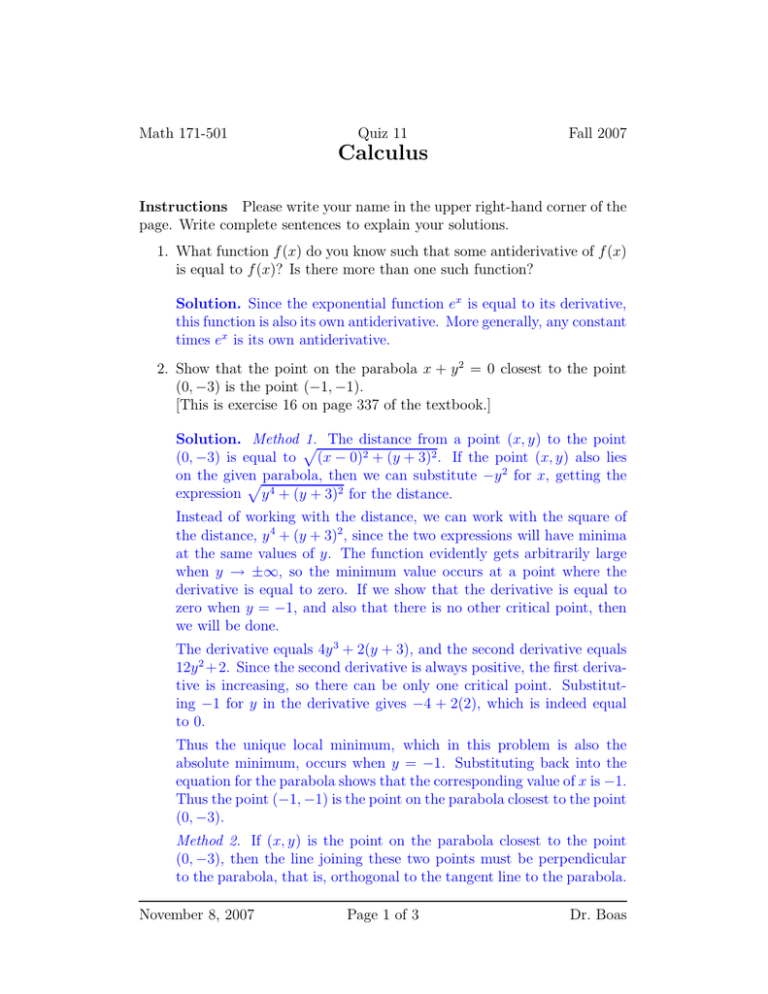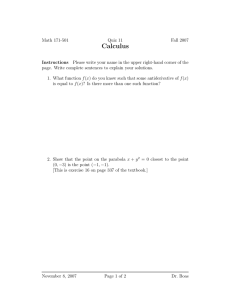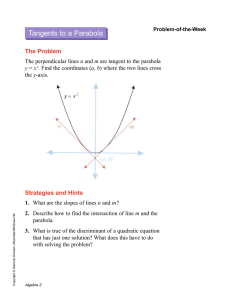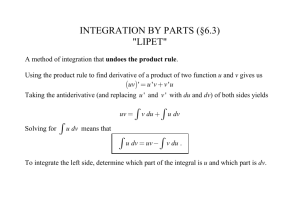Calculus
advertisement

Math 171-501 Quiz 11 Fall 2007 Calculus Instructions Please write your name in the upper right-hand corner of the page. Write complete sentences to explain your solutions. 1. What function f (x) do you know such that some antiderivative of f (x) is equal to f (x)? Is there more than one such function? Solution. Since the exponential function ex is equal to its derivative, this function is also its own antiderivative. More generally, any constant times ex is its own antiderivative. 2. Show that the point on the parabola x + y 2 = 0 closest to the point (0, −3) is the point (−1, −1). [This is exercise 16 on page 337 of the textbook.] Solution. Method p 1. The distance from a point (x, y) to the point (0, −3) is equal to (x − 0)2 + (y + 3)2 . If the point (x, y) also lies 2 on the given p parabola, then we can substitute −y for x, getting the expression y 4 + (y + 3)2 for the distance. Instead of working with the distance, we can work with the square of the distance, y 4 + (y + 3)2 , since the two expressions will have minima at the same values of y. The function evidently gets arbitrarily large when y → ±∞, so the minimum value occurs at a point where the derivative is equal to zero. If we show that the derivative is equal to zero when y = −1, and also that there is no other critical point, then we will be done. The derivative equals 4y 3 + 2(y + 3), and the second derivative equals 12y 2 + 2. Since the second derivative is always positive, the first derivative is increasing, so there can be only one critical point. Substituting −1 for y in the derivative gives −4 + 2(2), which is indeed equal to 0. Thus the unique local minimum, which in this problem is also the absolute minimum, occurs when y = −1. Substituting back into the equation for the parabola shows that the corresponding value of x is −1. Thus the point (−1, −1) is the point on the parabola closest to the point (0, −3). Method 2. If (x, y) is the point on the parabola closest to the point (0, −3), then the line joining these two points must be perpendicular to the parabola, that is, orthogonal to the tangent line to the parabola. November 8, 2007 Page 1 of 3 Dr. Boas Math 171-501 Quiz 11 Fall 2007 Calculus The slope of the line through (x, y) and (0, −3) equals (y + 3)/x, and when (x, y) is on the parabola, this slope equals (y + 3)/(−y 2). On the other hand, implicit differentiation shows that the slope dy/dx of the parabola satisfies the equation 1+2y(dy/dx) = 0, or dy/dx = −1/(2y). We are looking for the point on the parabola where the product of the two slopes equals −1: −1 y + 3 × = −1. 2y −y 2 This equation simplifies to 2y 3 + y + 3 = 0. Evidently y = −1 is a solution to the equation. Since the function 2y 3 +y+3 is increasing (because the derivative 6y 2 +1 is positive), there is no other solution. Thus the unique point on the parabola minimizing the distance to the point (0, −3) is the point where y = −1. 3. Find a function f (x) such that f ′′′ (x) = sin x, f (0) = 1, f ′ (0) = 1, and f ′′ (0) = 1. [This is exercise 40 on page 354 of the textbook.] Solution. Taking the antiderivative shows that f ′′ (x) = − cos x + c1 , and the initial condition f ′′ (0) = 1 shows that c1 = 2. Thus f ′′ (x) = 2 − cos x. Taking another antiderivative shows that f ′ (x) = 2x − sin x + c2 , and the initial condition f ′ (0) = 1 shows that c2 = 1. Thus f ′ (x) = 2x + 1 − sin x. Taking another antiderivative shows that f (x) = x2 + x + cos x + c3 , and the initial condition f (0) = 1 shows that c3 = 0. Thus f (x) = x2 + x + cos x. 4. Suppose f (x) = x4 − cx2 + x, where c is a constant (possibly positive or negative or zero). For what range of values of c does the graph of f have no inflection points? one inflection point? two inflection points? [This is based on exercise 26 on page 331 of the textbook.] Solution. We need to examine the second derivative f ′′ (x) = 12x2 −2c. When the constant c is negative, then f ′′ (x) is positive, so the graph is convex (concave up), and there is no inflection point. November 8, 2007 Page 2 of 3 Dr. Boas Math 171-501 Quiz 11 Fall 2007 Calculus When the constant c = 0, then f ′′ (x) is zero when x = 0. There is no inflection point, however, because f ′′ (x) is never negative: the concavity does not change at x = 0. When p c is positive, then there are two points where f ′′ (x) = 0: namely, x = ± c/6 . Since f ′′ (0) < 0, the graph is concave down near x = 0. Since f ′′ (x) is positive when x is a large positive number and also when x is a negative number of large magnitude, the graph is concave up when |x|p is large. Hence the concavity flips twice, once at each of the points ± c/6 : there are two inflection points. November 8, 2007 Page 3 of 3 Dr. Boas






